Historical Melbourne Attractions:
A Heritage Walk
You can walk to many historical Melbourne attractions and heritage buildings within the city. And then there are a also number a historical attractions and sites in the Melbourne outskirts.
You get to see many of these on one of the sightseeing Melbourne tours. Melbourne had its heydays as a result of the great gold rush in the late 1880s and early 1890s. But Melbourne history is short compared to other international cities.
A huge number of elaborate buildings were built during this peak period of Victorian architecture, making Melbourne one of the great Victorian cities, alongside London, Manchester, New York and Chicago.
Melbourne Attractions: South and central city
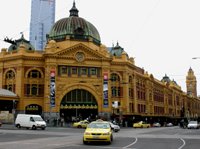 Begin your city heritage walk at Federation Square. There you find Flinders Street Station, an iconic Melbourne attraction with its original facade and clocks. The current building was completed in 1910, replacing the 1854 weatherboard sheds of the first city railway station.
Begin your city heritage walk at Federation Square. There you find Flinders Street Station, an iconic Melbourne attraction with its original facade and clocks. The current building was completed in 1910, replacing the 1854 weatherboard sheds of the first city railway station.
There is also the Princess Bridge, a historic bridge built in 1888, replacing two earlier bridges at the same site.
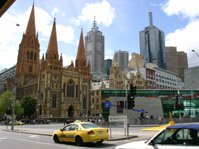 Crossing Flinders Street there is the 1861 Young and Jacksons hotel. This well known Victorian pub is famous for a nude portrait of Chloe above the bar.
Crossing Flinders Street there is the 1861 Young and Jacksons hotel. This well known Victorian pub is famous for a nude portrait of Chloe above the bar.
Across Swanston Street, you will see the St Pauls Cathedral, a Melbourne landmark and seat of the Anglican Archbishop of Melbourne. It was built in the 1880s in a Gothic Revival style.
Walking up Flinders Street away from the station, you will find the Forum Theatre on the corner of Russell Street. This 1929 structure was built in Moorish revival style with minarets and a clock tower. Today it is used as a concert hall.
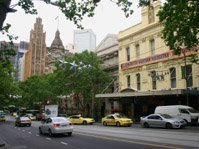 Walking up Russell and then down Collins Street, there is the Regent Theatre and the Athenaeum. The Athenaeum was completed in 1842. It houses a library and is home to the Melbourne Comedy festival. The Regent is a 1929 construction and host to the ballet and musicals.
Walking up Russell and then down Collins Street, there is the Regent Theatre and the Athenaeum. The Athenaeum was completed in 1842. It houses a library and is home to the Melbourne Comedy festival. The Regent is a 1929 construction and host to the ballet and musicals.
Back on Swanston Street you will see the Melbourne Townhall. The current building opened in 1870. It was designed by the same architect who also built the State Library and the Royal Exhibition Building. Today it is host to the Comedy Festival and the City of Melbourne government.
Across the road is the Capitol Theatre, a Chicagoesque cinema completed in 1924. It is now used by the university and as a festival venue.
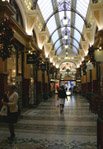 From there, take a walk down Collins Street to one of the famous Melbourne tourist attractions, the 1890s Block Arcade. It is a richly decorated space similar to the Galleria Vittoria in Milan and creates a connection to Little Collins (and Elizabeth) Streets.
From there, take a walk down Collins Street to one of the famous Melbourne tourist attractions, the 1890s Block Arcade. It is a richly decorated space similar to the Galleria Vittoria in Milan and creates a connection to Little Collins (and Elizabeth) Streets.
A good way to get to see the more hidden sights is to take one of the Melbourne walking tours. You'll be surprised what you missed, even as a local.
From Little Collins Street continue on through the Royal Arcade, another one of the famous Victorian arcades, which dates back even further to 1869. It connects to the Bourke Street mall.
On your left in Bourke Street you will find the GPO, a landmark structure, begun in 1859 and extended in 1887. Today, it is used as an up-market shopping complex.
Historical Melbourne Attractions: North and East
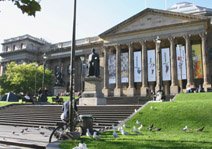 From the GPO take a walk up Bourke Mall back onto Swanston Street and head left. Just before La Trobe street you will find the momentous State Library of Victoria, built in 1853.
From the GPO take a walk up Bourke Mall back onto Swanston Street and head left. Just before La Trobe street you will find the momentous State Library of Victoria, built in 1853.
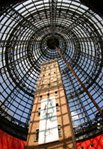 Across Swanston Street is Melbourne Central. The hub of this shopping complex is a large glass cone that encloses the Coops Shot Tower, which was built in 1890 and still used into the 1960s.
Across Swanston Street is Melbourne Central. The hub of this shopping complex is a large glass cone that encloses the Coops Shot Tower, which was built in 1890 and still used into the 1960s.
From Melbourne Central, walk up La Trobe Street to Russell Street. There you will find the old Melbourne Gaol, built in 1858. It is now a museum and reminder of the infamous Melbourne hanging days, including that of bushranger Ned Kelly.
Further on, in Exhibition Street, heading back towards the city centre, and you will come across Her Majesty Theatre, built in 1886, the then largest theatre in the Southern Hemisphere.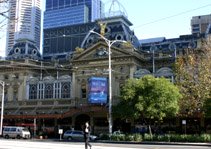
From there head up little Bourke Street. On Spring Street, you will find the magnificent Princess Theatre, completed in 1886. It impresses with its marble staircase and foyer and is talked about in the same breath as the Paris opera.
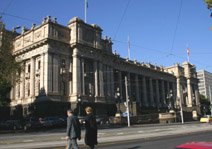 Across Spring Street is the Parliament House, the largest 19th century public building and the seat of the Victorian state parliament. Construction begun in 1856; from there it was completed in stages by 1929.
Across Spring Street is the Parliament House, the largest 19th century public building and the seat of the Victorian state parliament. Construction begun in 1856; from there it was completed in stages by 1929.
A bit further on, the Windsor Hotel, built in 1883 is the only remaining Australian Grand Hotel, taking you back into the bygone years.
Historical Melbourne Attractions outside the city square
From Spring Street it is just a short walk up Nicholson Street to the Royal Exhibition Building, one of the classic Melbourne attractions in the Carlton Gardens, completed in 1880.
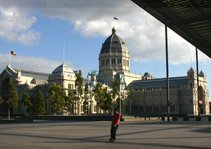 It is one of the world's oldest remaining exhibition pavilions and is a monument to the Melbourne gold rush heydays. It used to be a showcase for steam locomotives, fine china, silks and woolen textiles, jewellery, paintings and statues, and decorative pottery and is still used as an exhibition hall today.
It is one of the world's oldest remaining exhibition pavilions and is a monument to the Melbourne gold rush heydays. It used to be a showcase for steam locomotives, fine china, silks and woolen textiles, jewellery, paintings and statues, and decorative pottery and is still used as an exhibition hall today.
Walking back down Nicholson and Albert Streets you will get to St Patricks Cathedral, a massive blue stone structure built by Irish Catholics. Although its foundation stone was laid in 1858, it was not completed until after the 1890s due to gold rush labor shortage followed by the depression.
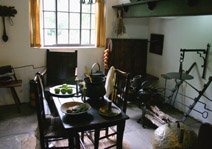
From there it is not far down Cathedral Place to the Fitzroy Gardens, where you will find Cooks Cottage. This is the original cottage built by the parents of Captain James Cook in 1755 in Yorkshire, England. It was transported to Melbourne in crates and barrels and re-assembled in the Fitzroy Gardens in 1934.
Historical Melbourne attractions south of the Yarra
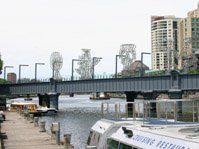 From the back of Flinders Street station you can cross the Yarra by foot via the Sandridge Bridge. It used to be an old rail bridge, built in 1888, and today carries a series of giant steel sculptures representing the waves of immigrants to Melbourne.
From the back of Flinders Street station you can cross the Yarra by foot via the Sandridge Bridge. It used to be an old rail bridge, built in 1888, and today carries a series of giant steel sculptures representing the waves of immigrants to Melbourne.
Up St Kilda Road you will find the Shrine of Remembrance. This huge post WW1 war memorial sits towering on a hill and is visible from Swanston Street. On Remembrance Day, November 11 at 11am (12 am with daylight saving), a single ray of sunlight penetrates into the Inner Sanctum of the Shrine.
Walk through the Kings Domain and you will get to the Government House, built in the 1870s. This grand edifice is the office and official residence of the Governor of Victoria.
Melbourne History: South Yarra and South Melbourne
Following Melbourne attractions are only about 1/2 hour from the city. You can visit La Trobes Cottage , the home of Charles Joseph La Trobe, the first Victorian governor, and his wife Sophie and their children from 1839 to 1854. It contains many original belongings of his family. It is open Sundays. Take #8 tram from Swanston Street to stop 22.
Only a short walk from South Yarra stations is the Como Historic House & Garden. It was built in 1847 and gives you a glimpse into the indulgent lifestyle of one of the wealthiest Australian pioneer families. With a historic mansion and a collection of antique furniture, set in impressive gardens, it is well worth a visit.
Due to the housing pressure created by the gold rush, Portable Iron Houses were erected in the 1850s in South Melbourne to house the fortune seekers. You can see them at 399 Coventry St. They are open on the first Sunday of each month from 1-4pm.
Here is a full list of Melbourne heritage listed buildings.
Do you like this page? Why not pay it forward with a Facebook 'Like' or Google
Follow us on Facebook, via our Newsletter, Blog or Twitter:
Like this site?
If you wish to receive our facebook updates, you will need to 'like' our Facebook page directly. Click here






 WLM on Facebook
WLM on Facebook INSIDERS News
INSIDERS News The WLM Blog
The WLM Blog Melbourne Twitter
Melbourne Twitter
New! Comments
Have your say about this! Leave us a comment in the box below.